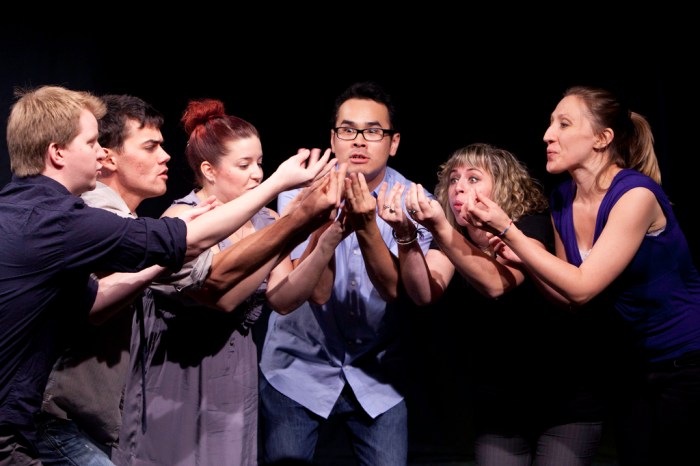
Ever wondered how spontaneous laughter and perfectly timed jokes can emerge from thin air? That’s the magic of improv comedy! From its humble beginnings to its current reign on stages worldwide, improv has evolved into a dynamic art form, blending wit, spontaneity, and audience interaction in a truly unique way. This exploration dives into the history, techniques, and business of making people laugh without a script – get ready for a comedic rollercoaster!
We’ll journey through the evolution of improv, exploring its diverse styles, from the rapid-fire exchanges of short-form to the intricate narratives of long-form. We’ll uncover the secrets behind iconic improv games and techniques, like the ever-important “Yes, and…” principle. We’ll even peek behind the curtain at the business side of things, examining how improv performers make a living and build successful careers.
Get ready to laugh, learn, and maybe even discover your inner comedian!
History of Improv Comedy
Improvisation, the art of spontaneous performance, boasts a rich and surprisingly long history, evolving from ancient theatrical traditions to the sophisticated forms we see today. Its journey reflects changing social contexts, technological advancements, and the creative genius of numerous individuals who shaped its development. This exploration will trace its evolution, highlighting key figures and movements, and contrasting earlier styles with contemporary approaches.
Early Influences and the Development of Improvisational Theatre
Improvisational elements have existed in performance for centuries. Ancient Greek comedies, particularly those of Aristophanes, featured actors riffing off each other and responding to audience suggestions, albeit in a structured framework. Medieval commedia dell’arte, with its stock characters and improvised dialogue, provides a more direct ancestor to modern improv. These troupes, travelling across Europe, relied heavily on improvisation to adapt their performances to different audiences and venues.
The flexible nature of their performances allowed for immediate responses to the energy of the crowd, a key element that persists in modern improv. Commedia dell’arte’s emphasis on physical comedy, character work, and audience interaction laid the foundation for many improvisational techniques still used today.
The 20th Century and the Rise of Modern Improv
The early 20th century saw the development of more structured approaches to improvisation within the context of theatrical training. Konstantin Stanislavski’s emphasis on emotional truth and spontaneous action in acting significantly influenced the development of improvisational techniques. While not strictly “improv” as we understand it today, his methods encouraged actors to tap into their own creativity and react authentically within a given scene, paving the way for future improv styles.
Key Figures and Movements
Several individuals played pivotal roles in shaping modern improv comedy. Viola Spolin, often considered the “mother of improvisation,” developed theatre games that emphasized spontaneity, collaboration, and creative problem-solving. Her work, documented in her influential book “Improvisation for the Theater,” provided a pedagogical framework for teaching and developing improvisational skills. Del Close, a highly influential figure in Chicago’s improv scene, developed a unique style that combined long-form improvisation with character development and narrative structure.
His teachings, passed down through his many students, continue to shape contemporary improv styles. Meanwhile, the Second City in Chicago became a breeding ground for innovative improv, launching the careers of numerous comedians including Bill Murray, John Belushi, and Dan Aykroyd. Their success helped popularize improv comedy, bringing it to a wider audience.
Comparing Early and Contemporary Improv Styles
Early improv, as seen in commedia dell’arte, tended to be more character-driven and reliant on physical comedy. The focus was on creating entertaining moments within a loose narrative structure. Contemporary improv, influenced by figures like Viola Spolin and Del Close, often incorporates more sophisticated narrative structures, character development, and ensemble work. While physical comedy remains a valuable tool, modern improv also emphasizes emotional depth, vulnerability, and the exploration of complex themes.
Long-form improvisation, which builds a complete narrative over an extended period, is a significant development of contemporary improv that distinguishes it from its earlier forms.
A Timeline of Improv Comedy Milestones
| Era | Key Figures | Significant Developments | Notable Performances/Groups |
|---|---|---|---|
| Ancient Greece (5th Century BC) | Aristophanes | Improvisational elements in comedic plays | Performances of Old Comedy in Athens |
| Medieval Period (16th-18th Centuries) | Commedia dell’arte troupes | Development of stock characters and improvised dialogue | Travelling Commedia dell’arte performances across Europe |
| Early 20th Century | Konstantin Stanislavski | Emphasis on emotional truth and spontaneous action in acting | Various Stanislavski-influenced theatrical productions |
| Mid-20th Century | Viola Spolin | Development of improv games and techniques | Workshops and classes using Spolin’s methods |
| Late 20th Century | Del Close, The Second City | Rise of long-form improv and the Chicago improv scene | The Second City performances, Upright Citizens Brigade |
| 21st Century | Numerous Improv Troups and Teachers | Continued diversification of styles, global spread of improv | Numerous improv comedy shows worldwide, online improv communities |
Improv Comedy Techniques and Styles
Improv comedy, at its core, is about spontaneity, collaboration, and embracing the unexpected. It’s a dynamic art form that relies on a set of techniques and styles to create hilarious and engaging performances. Understanding these techniques and styles is key to both appreciating and participating in improv. This section will delve into the foundational elements, exploring games, principles, and the diverse approaches that define the world of improv.
Improv Games and Exercises
Improv games and exercises are crucial for developing essential skills like listening, reacting quickly, and building upon others’ ideas. These structured activities provide a safe space to practice fundamental improv techniques and foster creative thinking. They range from simple warm-ups to complex scenarios designed to challenge and refine improvisers’ abilities.
- Yes, and…: This foundational principle encourages building upon what others have said, rather than negating or contradicting. For example, if someone says “I’m stranded on a desert island,” a response of “Yes, and… I’m a talking parrot who can help you build a raft” adds to the scene, creating a richer and more engaging narrative. It fosters collaboration and prevents scene derailment.
- One-Word Story: Participants take turns adding a single word to collaboratively create a story. This exercise emphasizes listening and quick thinking, as each word must seamlessly connect to the previous ones. The resulting story is often absurd and hilarious.
- Character Work: Exercises focusing on developing unique and believable characters help improvisers step outside their comfort zones and explore diverse personalities. This might involve creating a character based on a suggestion from the audience or developing a character with specific traits and motivations.
- Scenes from a Hat: Suggestions are drawn from a hat, providing the basis for scenes. This promotes adaptability and quick thinking, as improvisers must instantly develop a scene based on an unexpected prompt.
Core Improv Principles
Beyond “Yes, and…”, several other core tenets underpin successful improv. These principles guide improvisers in creating engaging and cohesive scenes. They are not just rules but guiding philosophies that shape the improvisational experience.
- Agreement: Building upon the “Yes, and…” principle, agreement involves accepting the reality of the scene as established by other improvisers. This doesn’t mean agreeing with everything, but rather accepting it as a foundation for further development.
- Listen Actively: Paying close attention to what your fellow improvisers are saying and doing is crucial. Active listening allows for spontaneous and meaningful responses, leading to richer and more cohesive scenes.
- Make Big Choices: Bold and unexpected choices often lead to the most memorable and hilarious moments. Embracing risk and committing fully to your choices keeps the energy high and prevents stagnation.
- Be Present: Fully engaging in the present moment is essential. Focusing on the scene and your fellow improvisers prevents overthinking and allows for spontaneous creativity.
Long-Form vs. Short-Form Improv
Improv can be broadly categorized into long-form and short-form styles. These categories differ significantly in structure, duration, and overall approach.
Short-form improv usually involves a series of short, unconnected games or scenes. It’s often fast-paced and relies on quick wit and comedic timing. Examples include games like “Scenes from a Hat” or “One-Word Story,” which focus on immediate comedic impact.
Long-form improv, on the other hand, involves creating a longer, more cohesive narrative with developed characters and a storyline. This style requires a higher level of collaboration and commitment, often resulting in more complex and emotionally resonant performances. Examples include “The Armando,” a long-form structure that builds a narrative through character interactions and evolving relationships.
Improv Styles
Different improv schools and traditions have developed unique styles and approaches. These styles often reflect the cultural context in which they emerged.
- Chicago Style: Known for its fast-paced, character-driven scenes, often incorporating physical comedy and heightened reality. It emphasizes game-playing and the creation of absurd situations.
- British Style: Often more subtle and character-based, with a focus on naturalistic dialogue and nuanced character interactions. It prioritizes character development and believable relationships.
- Del Close Style: Developed by Del Close, this style emphasizes heightened reality, character work, and the creation of unique and memorable characters. It encourages risk-taking and a commitment to the absurd.
Improv Comedy and Audience Engagement

Improv comedy thrives on the unpredictable energy of the moment, and a crucial element of that energy comes directly from the audience. A successful improv show isn’t just a performance; it’s a collaborative experience where the performers and the audience actively shape the narrative together. The audience isn’t just passive observers; they’re vital participants whose suggestions, reactions, and even silences directly influence the direction and tone of the show.Audience participation is the lifeblood of improv.
Improvisers actively solicit input from the audience, using suggestions as building blocks for scenes and characters. This interaction not only makes the show more unique and unpredictable but also fosters a sense of community and shared experience. The performers’ ability to seamlessly weave audience suggestions into the performance demonstrates their skill and adaptability, transforming potential obstacles into creative opportunities.
The energy of the audience, whether boisterous or quiet, informs the performers’ choices, influencing the pacing, tone, and overall style of the performance.
Audience Suggestion Incorporation
Improvisers employ various techniques to seamlessly integrate audience suggestions into their performances. One common approach is to use the suggestion as a jumping-off point, building a scene around a single word, phrase, or even a simple object. For example, if an audience member suggests “a runaway train,” the improvisers might create a scene about a group of friends trying to stop the train, or perhaps a comedic scene about the absurd situations that arise from a train careening through a town.
Another technique involves using the suggestion as a character trait, location, or relationship dynamic. If the suggestion is “a grumpy librarian,” the improvisers might develop a scene around a librarian who is unexpectedly confronted with a mischievous child or a series of bizarre events that challenge their composure. The key is to embrace the unexpected and find the humor in the unexpected connections between seemingly disparate ideas.
Building Rapport and Connection
Establishing a strong connection with the audience is paramount in improv. This involves more than just asking for suggestions; it’s about creating a sense of shared playfulness and mutual respect. Improvisers often use humor to break the ice and establish a comfortable atmosphere. This might involve self-deprecating jokes, acknowledging awkward silences with wit, or directly engaging with audience members through playful banter.
Eye contact, smiling, and acknowledging individual audience members are simple but effective ways to build rapport. The improvisers might also use audience members’ reactions as cues to adjust their performance, demonstrating responsiveness and a willingness to collaborate. For example, if the audience is laughing heartily at a particular bit, the improvisers might extend that bit, while a quieter response might signal a need to shift gears.
This ongoing dialogue between the performers and the audience is what makes improv such a dynamic and engaging art form.
Hypothetical Improv Show Structure with High Audience Interaction
This hypothetical show, titled “Audience Architects,” would heavily prioritize audience participation. The show would begin with a warm-up game where audience members provide a series of one-word suggestions, which would then be used as the foundation for a series of short, interconnected scenes. Following this, a longer, more elaborate scene would be developed based on a more detailed suggestion from the audience – perhaps a setting, a character type, or a specific conflict.
Midway through, the improvisers would conduct a quick audience poll to determine the direction of the scene, offering multiple options that stem from the established storyline. The final segment would involve an interactive game where audience members participate directly in the scene, playing minor characters or providing sound effects. This structure ensures constant audience engagement throughout the entire performance, transforming the audience from passive observers into active collaborators.
The Business of Improv Comedy
Improv comedy, while often perceived as a purely artistic endeavor, is also a viable career path for dedicated and resourceful performers. Success, however, requires a multifaceted approach encompassing performance skills, business acumen, and a strong understanding of the market. This section explores the various avenues for income generation, the challenges and rewards of a career in improv, the business models of different improv venues, and a hypothetical business plan for a new troupe.
Avenues for Income Generation
Improv performers can earn a living through a variety of channels. Traditional avenues include paid performances at established theaters and comedy clubs. These venues often offer regular shows, providing consistent income for their resident troupes. Beyond stage performances, many improvisers supplement their income by teaching workshops and classes. These workshops cater to both aspiring comedians and individuals seeking to improve their communication and teamwork skills.
The corporate world also presents a lucrative market for improv performers, who are frequently hired to conduct team-building exercises, deliver engaging presentations, or provide entertainment at corporate events. Finally, some improvisers build a successful career through online platforms, offering virtual workshops, creating online content, or performing in online shows.
Challenges and Rewards of a Career in Improv Comedy
Pursuing a career in improv comedy presents both significant challenges and rewarding experiences. The unpredictable nature of the field, with its reliance on gig work and fluctuating income, necessitates strong financial planning and resourcefulness. Competition for gigs, especially in larger cities, can be intense. Furthermore, the constant need to adapt, innovate, and develop one’s comedic skills demands continuous effort and self-improvement.
However, the rewards are equally compelling. The creative freedom, the opportunity to connect with audiences on a deeply personal level, and the camaraderie among fellow performers create a uniquely fulfilling professional environment. The constant learning and growth inherent in improv also contributes to a sense of personal and professional satisfaction.
Business Models of Improv Venues and Companies
Improv venues and companies employ various business models to generate revenue. Some venues operate as non-profit organizations, relying on grants, donations, and ticket sales to cover their costs. Others operate as for-profit businesses, seeking to maximize profits through ticket sales, merchandise, food and beverage sales, and corporate event bookings. Some companies focus on providing training and workshops, generating revenue primarily through class fees.
Others build their business around producing and performing shows, relying heavily on ticket sales and sponsorships. The successful business model often depends on the venue’s location, target audience, and overall mission. For example, a small, community-based improv theatre might prioritize community engagement over maximizing profits, while a large, established improv company in a major city may focus on a broader revenue stream, including corporate events and merchandise sales.
Hypothetical Business Plan for a New Improv Comedy Troupe
This section Artikels a hypothetical business plan for a new improv comedy troupe, “The Spontaneous Spontaneities.”
| Section | Strategy | Resources | Timeline |
|---|---|---|---|
| Marketing | Social media campaign, local media outreach, partnerships with community organizations, flyers and posters. | Social media accounts, design software, printing resources, local media contacts. | Months 1-3: Social media build-up; Months 4-6: Local partnerships and outreach; Ongoing: Content creation and promotion. |
| Funding | Crowdfunding campaign, grants, sponsorships, ticket sales. | Crowdfunding platform, grant writing expertise, sponsorship proposals, ticketing system. | Months 1-2: Crowdfunding campaign; Months 3-6: Grant applications and sponsorship outreach; Ongoing: Ticket sales. |
| Venue | Secure a flexible performance space (e.g., a community center, bar with a stage). | Venue scouting, negotiation skills, rental agreement. | Month 1-2: Venue search; Month 3: Secure rental agreement. |
| Programming | Develop a diverse range of shows, including long-form, short-form, and themed improv performances. | Experienced improvisers, creative writing skills, show planning. | Month 1-3: Show development; Ongoing: Performance schedule. |
| Financial Projections | Project revenue based on ticket sales, sponsorships, and workshops. Estimate expenses for venue rental, marketing, and other operational costs. Develop a realistic break-even point. | Spreadsheet software, financial modeling skills, market research. | Month 1: Develop financial projections; Ongoing: Monitor and adjust financial plans. |
Improv Comedy and Entertainment & Humor

Improv comedy occupies a unique and vibrant space within the broader landscape of entertainment and humor. Unlike scripted comedy, its reliance on spontaneity and audience interaction creates a dynamic and unpredictable experience, appealing to audiences seeking both laughter and a sense of shared creative energy. This inherent unpredictability is a key factor in its enduring appeal, offering a refreshing contrast to the more structured forms of comedic performance.Improv comedy’s success hinges on its ability to weave together several elements of humor, often in unexpected and delightful ways.
The very nature of improvisation necessitates a quick wit and the ability to build upon the contributions of fellow performers, creating a collaborative comedic tapestry.
Improv Comedy Compared to Other Comedic Forms
Improv comedy differs significantly from other comedic forms, such as stand-up and sketch comedy. Stand-up relies heavily on pre-written material and the performer’s individual comedic style, while sketch comedy uses pre-written scripts and characters within defined scenarios. In contrast, improv emphasizes improvisation and collaboration, with the humor arising spontaneously from the interactions between performers and the suggestions from the audience.
This collaborative, reactive nature distinguishes improv from the more controlled and predetermined nature of stand-up and sketch comedy. The humor generated is often more unpredictable and directly responsive to the moment.
Elements of Humor in Improv Comedy
Improv comedy effectively utilizes a range of humor techniques. Wordplay, including puns, double entendres, and unexpected phrasing, is a common tool. Physical comedy, ranging from slapstick to subtle gestures, adds another layer of humor, often enhancing the verbal wit. Observational humor, drawing on relatable everyday experiences, creates a sense of shared understanding and connection with the audience. The absurdity of unexpected situations and character interactions also generates laughter, highlighting the unpredictable and often illogical nature of improvised scenarios.
The skillful use of these elements, often blended seamlessly, is crucial to the success of an improv performance.
Example of a Funny Improv Scene
Imagine a scene set in a bizarre, futuristic laundromat on Mars. Two characters, a hyper-enthusiastic Martian named Zorp with three eyes and a perpetually grumpy Earthling named Brenda, are waiting for their clothes. Zorp, convinced that his clothes are communicating with him through advanced alien technology, attempts to interpret their “messages” resulting in increasingly absurd pronouncements about upcoming Martian meteor showers and the latest trends in intergalactic fashion.
Brenda, meanwhile, constantly complains about the lack of decent detergent on Mars and the exorbitant cost of drying cycles. The humor derives from the clash of personalities, the outlandish setting, and the escalating absurdity of Zorp’s interpretations of his clothes’ “messages.” Physical comedy is employed through Zorp’s exaggerated movements as he “listens” to his clothes and Brenda’s exasperated sighs and eye rolls.
The wordplay comes from Zorp’s Martian slang and Brenda’s sarcastic comments about Martian life. The scene culminates in a chaotic misunderstanding when Zorp accidentally shrinks Brenda’s favorite shirt using his “alien clothes communicator” leading to a hilarious outburst from Brenda and a series of increasingly frantic attempts by Zorp to fix the situation, further amplifying the comedic effect.
Improvisation in Other Fields
Improvisation, often associated with the entertainment industry, transcends the stage and finds practical application across diverse professional fields. Its core principles – adaptability, quick thinking, and collaborative problem-solving – are valuable assets in navigating the complexities of modern workplaces and fostering innovative solutions. This section explores the surprising versatility of improv techniques and their impact on various sectors.Improvisation Techniques in Diverse Professional Settings
Improvisation in Business
Improvisation enhances business communication and problem-solving through spontaneous collaboration and creative thinking. Imagine a brainstorming session where team members freely build upon each other’s ideas without fear of judgment, fostering a dynamic exchange of perspectives. This “yes, and…” approach, a cornerstone of improv, encourages building upon existing ideas rather than dismissing them. In negotiations, improv skills allow for quick adaptation to unexpected proposals and the crafting of creative solutions.
For instance, a sales team utilizing improv techniques might be better equipped to handle unexpected customer objections by formulating persuasive counterarguments on the spot, maintaining a positive and engaging interaction. The ability to think on your feet and adjust strategies rapidly is invaluable in fast-paced business environments.
Improvisation in Education
In education, improvisation fosters active learning and student engagement. Teachers employing improv exercises can create dynamic classroom environments where students actively participate and develop critical thinking skills. Role-playing scenarios, for example, allow students to practice communication and problem-solving in a safe and controlled environment. Improvised debates and presentations cultivate quick thinking and confident public speaking. Furthermore, improv can help students overcome stage fright and build self-confidence, essential skills for academic success and future careers.
A history class might utilize improv to recreate historical events, allowing students to inhabit the roles of historical figures and understand the complexities of their decisions and actions.
Improvisation in Therapy
Improvisational techniques are increasingly used in therapeutic settings to enhance communication and self-discovery. Role-playing exercises can help clients explore difficult emotions and situations in a safe and controlled environment. The non-judgmental and supportive atmosphere of improv sessions creates space for self-expression and personal growth. Improvisation allows therapists to observe clients’ reactions and behaviors in real-time, providing valuable insights into their thought processes and emotional patterns.
For example, a therapist might use improv to help a client practice assertive communication in a safe setting, role-playing different scenarios and providing feedback.
Workshop Curriculum: Enhancing Teamwork and Creativity in a Corporate Setting
This curriculum utilizes improv techniques to build teamwork and foster creativity within a corporate environment.
Module 1: Introduction to Improvisation Principles
This module introduces core improv concepts like “yes, and…”, active listening, and character development. Participants will engage in simple improv games to understand the principles in action. Examples include character introductions, object work, and basic scene work.
Module 2: Communication and Active Listening
This module focuses on enhancing communication skills through improv exercises. Participants will practice active listening, mirroring techniques, and responding thoughtfully to build upon each other’s ideas. This section will include exercises focused on non-verbal communication and understanding unspoken cues.
Module 3: Collaborative Problem-Solving
This module uses improv games to encourage collaborative problem-solving. Participants will work together to overcome challenges presented in improvised scenarios, focusing on brainstorming and building upon each other’s solutions. This will include scenarios relevant to the workplace, such as addressing a customer complaint or solving a logistical problem.
Module 4: Building Trust and Team Cohesion
This module focuses on trust-building exercises through improv games. Participants will engage in activities requiring them to rely on each other and support each other’s ideas, building confidence and a stronger team dynamic. Trust falls (with appropriate safety measures) and other physically engaging exercises could be included.
Module 5: Presentation and Public Speaking
This module utilizes improv techniques to enhance presentation and public speaking skills. Participants will practice impromptu speeches, storytelling, and responding to unexpected questions, building confidence and fluency. This includes feedback sessions focused on body language and audience engagement.
Closing Summary
So, there you have it – a whirlwind tour of the amazing world of improv comedy! From its historical roots to its modern-day manifestations, improv continues to captivate audiences and challenge performers. Whether you’re a seasoned performer, a curious observer, or simply someone who appreciates a good laugh, the principles of improv can enrich your life in countless ways.
So go forth, embrace the unexpected, and say “Yes, and…” to the possibilities!
Frequently Asked Questions
What’s the difference between short-form and long-form improv?
Short-form improv uses quick games and exercises, often relying on audience suggestions. Long-form improv creates a longer, more developed narrative with characters and a storyline.
Is improv difficult to learn?
It takes practice, but anyone can learn the basics of improv! It’s about embracing spontaneity and building confidence.
Can I use improv skills in my everyday life?
Absolutely! Improv improves communication, problem-solving, and adaptability – valuable skills in any field.
Where can I find improv classes near me?
Check online for local improv theaters or community centers. Many offer beginner classes.
What if I freeze up during an improv scene?
Don’t worry, it happens to everyone! Experienced improvisers have techniques to help navigate those moments, and the audience is usually very forgiving.





